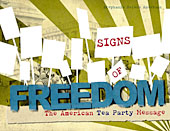“I attended an Appleseed and all I got was this lousy T-shirt!” – N.U.G.U.N.
The shirt was in fact pretty snazzy. And I walked away with a LOT more than just a shirt from my first Appleseed. Now onto the review…
The first thing we were instructed to do was to leave rifles in our vehicles until after the safety instruction.
The safety lesson focused on four rules. These were semi-specific to Appleseed and not the traditional four rules. They closely follow the NRA’s Gun Safety Rules.
1. Always keep muzzle pointed in a safe direction
This first one is a standard safety rule. Appleseed helps facilitate this by providing a painted firing line, and a second range line several feet behind.
Appleseed instructors are very diligent on ensuring that all rifles are kept safely pointed downrange. They go one step further in requiring students to keep the muzzles lined up just over the firing line and everything else being kept behind. This helps to ensure that no student is above or behind the muzzle of another student’s rifle.
I believe it’s a very good practice for teaching a large number of people who may or may not be familiar with firearms.
2. Keep your finger off the trigger until you are sighted in and ready to fire.
Once again this is a pretty standard rule.
3. Do not load until the load command is given.
This is essentially a variant on the NRA’s third rule of keeping the gun unloaded until ready to use it. This change helps facilitate the control of loading to the instructor.
4. Observe your fellow students and ensure they are following the rules.
Appleseed encourages everyone to be aware of their fellow students and that their neighbors are acting in a safe manner according to the provided rules. They also inform students that any student is allowed to call out “ceasefire” initiating a stand down of all students at any time that they observe a situation that might affect safety.
I think that this is a very good instruction point. Though I believe it should be taken a step further. I would actually engage in a few practice calls by students to call out cease fire. Selecting those students who feel most timid.
Why do I advocate this? I have observed an interesting scenario on more than several occasions during fire alarm drills. People walk past the emergency exits choosing to proceed out through the standard exits; requiring longer routes. In fact was once told “You can’t go that way!” as I proceed out of an emergency exit during an alarm. We’re so ingrained NOT to go out such exits that even when we’re supposed to we fail to utilize them. While most of those cases were merely drills. We did find out later that one of them was in fact not a drill.
I strongly advocate empowering the individual in those matters that effect one’s safety. Empowering a student with the authority to declare a ceasefire situation is a good thing. Waiting for a student to flag down an instructor in order to call out a ceasefire will cause a delay that might result in an incident.
After the safety instruction we were given instruction in regards to the range commands. A call was given for “Preperation time has begun.” It was at this point, and only at this point that we could leave the safe zone demarked by a painted line and proceed to our rifles. At which point we were allowed to get into firing position and ready our rifles – except for loading.
Every student was given a chamber flag to demark their rifle as cleared.
The range master would then check with his fellow instructors calling out “ready on the right?” “ready on the left?” “all ready?”. At which point the command to “load your rifles” would be given. Only at this point was a rifle to have a round chambered. Finally the range master would call out the “fire” command.
One thing that was interesting is that the instructors endeavored NOT to use the word “fire” in speech during the shooting instruction period. Preferring to refer to it by the moniker “F-word”.
When the alloted time for shooting had ended. The range master would shout out “Ceasefire! Ceasefire! Ceasefire!” which would be ecoed down the line by the other instructors. Rifles were to be set down and hands removed at this time. Shortly thereafter the range master would instruct everyone to “make clear”.
The clearing process being remove magazine, clear chamber and lock open, turn on safety, place chamber flag indicator into rifle. Set rifle down ensuring the muzzle was about two inches over the firing line. Then step back and proceed out of the firing range area into the safety area. The instructors would then walk down the line and ensure everyone’s rifle had been made safe.
This procedure was pretty much replicated throughout the training. Often followed by a gathering for next bit of instruction.
So what does Appleseed teach?
***
Appleseed Training:
The Appleseed Program implements a method of initial assessment followed by instruction and constant re-assessment with the purpose of graduating “riflemen”.
First they have us shoot one of their custom targets which is based of the military AQT silhoutte except in red to represent the British regulars or “redcoats”. There are four target silhouette, each representing a different relative distance: 100 yds, 200 yds, 300 yds and 400 yds. With a fifth target that is small rectangle which represents an head size target at 250 yds. This first target becomes your initial assessment. They require three hits on a given silhouette to qualify as “effective” at the range – except for the head shot which requires a single shot.
I was not effective at any range. I landed two hits to the 100 yd target and one to the 400 yd – but that was probably more luck than skill.
Appleseed puts a lot of focus on the benefits of the use of a sling with riflery. One of the first marksmanship instruction we were provided was the use of a sling in the prone position.
We were shown how to attach the sling to our upper arm. Wrap our hand thru, and let the fore stock of the rifle rest in our hand. Bringing our left elbow underneath the rifle. Creating a triangle kept taught by the arm bones and the tension of the sling. Likewise we were shown how to bring our right leg up while extended our left. We would later be introduced to Natural Point of AIM or NPOA for short.
I was loosely familiar with the term. I understood that it was a reference to having your body’s position result in your firearm pointing toward the target naturally. But I had no knowledge of implementation and my few attempts at practicing such with a pistol were less than encouraging.
NPOA makes a lot more sense to me in reference to the prone position. And the use of the positioning of one’s body so that the relaxed or default state keeps the front sight on target.
We were also shown how our breathing affects sight acquisition. How in the prone position breathing causes the front sight to move up and down. And to key our shots to the point inbetween our breaths. As empty lungs makes for the most uniform position. So we were instructed to breath in and to breath out pausing briefly at the end of the exhale in order to fire. Later we would be instructed to make multiple shots in time with the sequence of breathing.
Breath-in, breath out, pause and shoot…
Breath-in, breath out, pause and shoot…
Breath-in, breath out, pause and shoot…
They referred to this as the rifleman’s cadence.
We would also be taught the basics of sling use and positioning in both the sitting and standing positions. The sitting position requires the resting of ones arms upon the outside of ones knees. I found that my complete lack of flexibility and inability to sit indian style since I was 4 yrs old makes the sitting position unwieldly and unusable for me. Instead I had to fallback on the “kneeling” position which is much less accurate. My accuracy suffered. But I did improve the technique by cantelevering my support arm and resting it against the inside of my left knee. This increased stability and allowed me to bring shots on target while kneeling. Where beforehand my shots were spread all over the place.
We would utilize a few other targets including a square sight-in target and a modified AQT (Army Qualification Test) target. Which have been scaled to correspond to a 25 yard range.
The instructors also explain why the range of 25 yards is used. How distance affects accuracy as you extend the angles out. Explaining the term Minute-of-Angle (MOA). Showing how the targets we are utilizing correspond to a 4 minute of angle at 400 yards. And how that corresponds to the size of an human torso.
By the end of the day I could see some noticeable improvement. When we reshot the “redcoat” target. This time I place two rounds in each of the 100 yd, 200 yd, and 300 yd targets. Still not enough to be considered “effective” at any of those ranges. But a noticeable improvement.
***
What is an American Rifleman?
If Appleseed was just about marksmanship, it’d be well worth the cost. However, Appleseed has another focus – education.
A large part of the Appleseed focuses on the history of the American Revolution. (Don’t worry, it’s not so much as to impede from the riflery training. Most of the history lessons are taught during breaks and lunch.)
Students are given an overview of some of the issues that led up to the American Revolution. Accounts of the battles of Lexington and Concord. How things went down. Why they went down differently in Concord. And the effect of marksmanship on the part of the American revolutionaries.
We also receive a few corrections to the traditional (mis)history many are taught in school. Such as Paul Revere’s famous ride calling out the “British are coming”. They explained that at the time all the colonials considered themselves British. It was not so much the British were coming but that the regulars are coming. Talked about how the right of the colonial leaders to assemble had been taken away. And that the British regulars were being sent out in order to disarm the colonials of their powder, arms and any cannon. And how these correspond to the productions of the 1st and 2nd Amendments.
I found the history a wonderful touch to the training. And am glad that it was included by Appleseed.
—-









Cool!
[…] Appleseed: Day One […]
[…] Appleseed: Day One […]